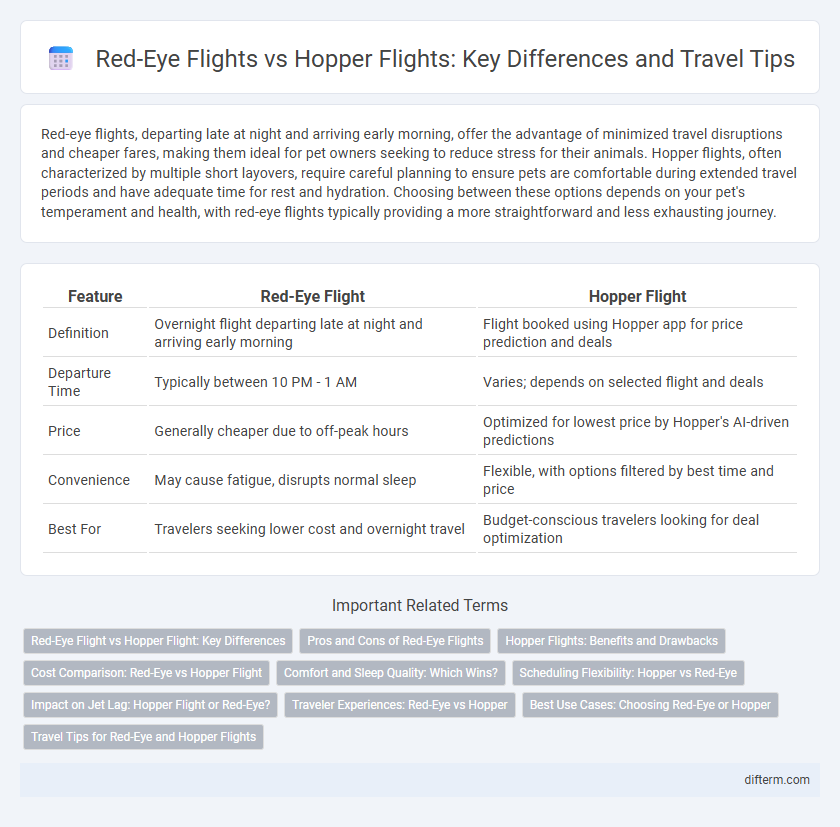Red-eye flights, departing late at night and arriving early morning, offer the advantage of minimized travel disruptions and cheaper fares, making them ideal for pet owners seeking to reduce stress for their animals. Hopper flights, often characterized by multiple short layovers, require careful planning to ensure pets are comfortable during extended travel periods and have adequate time for rest and hydration. Choosing between these options depends on your pet's temperament and health, with red-eye flights typically providing a more straightforward and less exhausting journey.
Table of Comparison
| Feature | Red-Eye Flight | Hopper Flight |
|---|---|---|
| Definition | Overnight flight departing late at night and arriving early morning | Flight booked using Hopper app for price prediction and deals |
| Departure Time | Typically between 10 PM - 1 AM | Varies; depends on selected flight and deals |
| Price | Generally cheaper due to off-peak hours | Optimized for lowest price by Hopper's AI-driven predictions |
| Convenience | May cause fatigue, disrupts normal sleep | Flexible, with options filtered by best time and price |
| Best For | Travelers seeking lower cost and overnight travel | Budget-conscious travelers looking for deal optimization |
Red-Eye Flight vs Hopper Flight: Key Differences
Red-eye flights typically depart late at night and arrive early morning, maximizing daytime availability for travelers, while Hopper flights focus on providing flexible, budget-friendly options by predicting and comparing flight prices through their app. Red-eye flights often offer less crowded cabins and cheaper fares but may result in traveler fatigue due to disrupted sleep patterns. Hopper flights emphasize data-driven booking strategies with features like price alerts and travel trend predictions, enabling users to find optimal flight deals beyond just red-eye options.
Pros and Cons of Red-Eye Flights
Red-eye flights, typically departing late at night and arriving early morning, offer travelers the advantage of maximizing daytime hours at their destination and often cheaper ticket prices compared to daytime flights. Passengers can experience less crowded airports and cabins during these flights, which may contribute to a quieter, more restful journey. However, red-eye flights can disrupt circadian rhythms, leading to fatigue and discomfort upon arrival, and may not suit travelers with young children or those sensitive to irregular sleep patterns.
Hopper Flights: Benefits and Drawbacks
Hopper Flights offer travelers flexible booking options and real-time price predictions that help secure the best deals, making them ideal for budget-conscious passengers. These flights often provide a balance between cost and convenience, avoiding the exhaustion associated with Red-Eye Flights while still allowing for late departures or early arrivals. However, the dynamic pricing model can sometimes lead to price fluctuations, and limited flight availability may restrict choices during peak travel seasons.
Cost Comparison: Red-Eye vs Hopper Flight
Red-eye flights typically offer lower ticket prices due to their inconvenient overnight schedule, making them a cost-effective option for budget travelers. Hopper flight predictions leverage advanced algorithms to identify the best times to book, often securing cheaper fares by tracking price fluctuations in real-time. Comparing costs, red-eye flights generally maintain steady low prices, while Hopper-based bookings can sometimes yield better deals if booked at optimal times identified by the app.
Comfort and Sleep Quality: Which Wins?
Red-eye flights often offer quieter cabins and fewer disturbances, enhancing sleep quality despite cramped seating. Hopper flights prioritize convenience with flexible booking but may involve irregular schedules that disrupt comfort and rest. For travelers valuing uninterrupted sleep and overall comfort, red-eye flights typically provide a more restful experience.
Scheduling Flexibility: Hopper vs Red-Eye
Hopper flights typically offer greater scheduling flexibility by providing numerous time options throughout the day, allowing travelers to choose departure times that best fit their itineraries. Red-eye flights are more limited, generally departing late at night and arriving early morning, which suits travelers prioritizing overnight travel but restricting time choice. For flexible scheduling needs, Hopper's multiple daily flights accommodate varied preferences better than the fixed late-night slots of red-eye flights.
Impact on Jet Lag: Hopper Flight or Red-Eye?
Red-eye flights, departing late at night and arriving early morning, often align better with natural sleep cycles, potentially reducing jet lag by allowing passengers to sleep during the flight. Hopper flights, typically shorter connections optimized by apps like Hopper, may disrupt sleep patterns due to varying departure times and layovers, increasing jet lag risk. Choosing a red-eye flight can enhance circadian rhythm adjustment, making it a preferred option for minimizing jet lag effects.
Traveler Experiences: Red-Eye vs Hopper
Red-eye flights offer travelers the advantage of maximizing daytime hours at their destination but often come with challenges such as fatigue and disrupted sleep patterns. Hopper flights, optimized through predictive pricing algorithms, provide travelers with more flexibility in scheduling and potential cost savings, enhancing overall travel convenience. Passenger reviews highlight that while red-eye flights may lead to tiredness upon arrival, hopper flights contribute to a more relaxed planning experience and improved satisfaction with flight timing choices.
Best Use Cases: Choosing Red-Eye or Hopper
Red-eye flights are ideal for business travelers seeking to maximize daytime productivity by flying overnight and arriving early at their destination. Hopper flights, booked via the Hopper app, offer great value for leisure travelers flexible with dates, as the app predicts optimal booking times for the lowest fares. Choosing between red-eye and Hopper flights depends on priorities such as time efficiency versus cost savings and flexibility in travel schedules.
Travel Tips for Red-Eye and Hopper Flights
Red-eye flights offer the advantage of maximizing daytime at your destination but require strategies like packing earplugs, eye masks, and scheduling light meals to improve comfort and rest. Hopper flights, designed with flexible ticketing and fare predictions, help travelers secure the best prices by monitoring price trends and booking at optimal times. Prioritize hydration, choose window seats for better sleep opportunities, and plan layovers strategically to reduce travel fatigue on both red-eye and hopper flights.
Red-Eye Flight vs Hopper Flight Infographic

 difterm.com
difterm.com